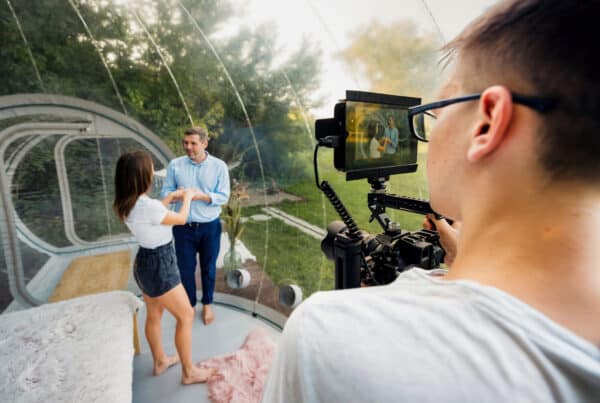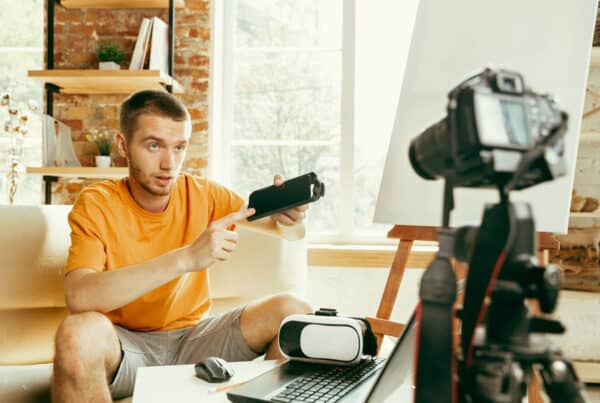In the evolving landscape of filmmaking, the advent of 360 degree video production has opened a new frontier, creating fresh opportunities and unique challenges. Do you often find yourself wondering how 360 video production measures up against traditional filmmaking? Are you curious about the advantages each method offers, as well as the misconceptions surrounding these dynamic forms of storytelling? You’re in the right place. Let’s dive into the world of 360 degree video production and traditional filmmaking, revealing their strengths, weaknesses, and the truth behind common myths.
Understanding 360 Degree Video Production
Welcome to the captivating world of 360 degree video production, the viewer becomes the explorer! Imagine stepping into the shoes of Indiana Jones, minus the fedora and ancient artifacts, of course. This thrilling medium captures life not just through a lens, but in a 360-degree embrace, offering a comprehensive panorama that envelopes the audience in the story. As a result, this innovative style of filmmaking is more of a come-and-see exploration rather than a watch-and-leaving experience. In a traditional film, the director decides what part of the frame you see. In 360 video, it’s like the director graciously hands you the remote control of your own adventure!
As with all things in life, it’s not without its myths. Sometimes people think 360 video is only applicable for high-octane, adrenaline-filled scenarios or just VR video production—cue the misconception siren. While it does pair beautifully with virtual reality, its applications stretch far beyond the realms of gaming or sci-fi. In fact, industries like tourism and education have embraced 360 video with open arms. Want to tour the Louvre while having your morning cereal? Or explore the Great Barrier Reef without needing a snorkel? Educational 360 video production enables just that, breaking geographical barriers and opening up a world of learning opportunities.
When it comes to corporate communications and marketing, 360 video production is reinventing the wheel. Imagine a boardroom presentation where you can literally walk around the virtual office or a product demo that allows users to explore all angles before making a purchase—talk about hands-on experience! Forward-thinking companies are utilizing VR video production services as a pivotal part of their communication strategy.
“360 degree video gives you the ability to not only be inside the story but to experience it from all angles—a revolutionary narrative that defies the ordinary frame.” — Unknown
Pioneers in the field, such as those providing VR video production services, are paving the way for these interactive experiences, making the technology more accessible to content creators and brands. Platforms and services dedicated to 360 degree video platforms are leading this charge, opening new vistas for storytelling across sectors. With the right guidance, the sky’s the limit—figuratively and literally, if you’re shooting a drone 360 video production!
Remember, no special glasses are required to see the potential of 360 video production. With its ability to engage and immerse, it’s more than just a trend; it’s a gateway to experiences that make the ordinary, extraordinary.
The Mechanics of Traditional Filmmaking
Traditional filmmaking, often seen as the grandparent waving stubbornly on the while the kids with their fancy 360 video capture gear run around the yard, has its roots deeply entrenched in linear storytelling. is the cinematic technique that built Hollywood’s golden age, where directors are the unsung heroes who meticulously curate every frame like perfectionists arranging a carefully curated art collection. Directors craft each scene with a precision that a brain surgeon might envy, using a blend of camera angles, lighting, and editing to guide the audience’s focus exactly where they intend it to land. According to the Statista Research Department, global box office revenue for traditional films reached approximately $21.3 billion in 2021, showing that it’s still a powerful medium.
Traditional filmmaking has the prowess to tell stories with immense emotional depth and laser-focused narratives. It manipulates perspective and pacing like a symphony conductor orchestrating a crescendo, drawing viewers into the folds of the story with deliberate and often mesmerizing techniques. Remember the tear-jerking climax of Titanic? That was no accident—traditional filmmaking knows exactly how to pull at your heartstrings.
However, this also entails a more passive experience for viewers. In traditional cinema, the audience doesn’t have to navigate through alternate reality or avoid dragons hiding in 360 video production (unless Mozart’s Don Giovanni is up to his tricks again). Viewers sit back, relax, and allow the film to guide them like a wise elder telling tales by the fireside. While immersive video creation offers wanderlust-like freedom for your imagination, traditional filmmaking remains akin to following a path through a storybook—one that is carefully constructed for every beat, climax, and resolution. Or as Alfred Hitchcock once eloquently put it:
“Drama is life with the dull bits cut out.” — Alfred Hitchcock
Advantages of 360 Degree Video Production
When it comes to creating unforgettable experiences, 360 degree video production takes cake—or, in this case, the whole bakery. Its immersive nature not only revolutionizes how stories are told but also offers distinct advantages over traditional filmmaking. Let’s dive into what makes this format so appealing.
- Interactivity: Ever been to a movie and wished you could change the angle to get a better view of Meryl Streep’s legendary acting? With 360 video, viewers are in the director’s seat. They have the power to shift perspectives, creating a dynamic viewing experience that’s as interactive as it is engaging.
- Immersion: Picture this: you’re not just watching a coral reef on your flat screen; you’re snorkeling through it, all from the comfort of your couch. “The great thing about 360 video is its ability to ‘transport’ you,” notes an industry insider. Virtual reality video production lets you step inside created worlds, providing an unmatched sense of presence and involvement.
- Versatile Applications: The potential for immersive content creation is vast and varied. From tourism 360 video production that lets potential tourists stroll through picturesque destinations before booking a flight, to educational 360 video production where students can explore ancient ruins without the bug spray—360-degree storytelling makes education and entertainment both efficient and exciting.
- Cutting-edge Marketing: If James Bond had a video strategy, you better believe it would involve 360 video marketing. It isn’t just about standing out–it’s about creating memorable brand experiences. This innovative approach means your audience isn’t just passively consuming content; they’re stepping inside your brand’s universe.
With stats showing that interactive content generates double the engagement compared to static content, it’s clear that 360 degree video production is not just a trend—it’s a transformative tool in digital storytelling. Whether you’re in marketing, education, or just want to offer the thrill of a VR roller coaster ride, the 360-degree format makes any narrative feel real and remarkable.
Misconceptions About 360 Degree Video Production
In the world of 360 Video Production, there’s no shortage of rumors myths that tend to cloud the skies. Let’s clear up some of these misconceptions, shall we?
- It’s only for tech enthusiasts: Contrary to popular belief, 360 video production isn’t just an exclusive domain for the tech-savvy or VR gamers lurking out there. While it certainly gained traction in tech circles, many industries are now getting to the heart of its potential. Education, real estate, and tourism have been quick to jump on board. Case in point, the tourism sector is harnessing 360-degree video for virtual tours, bringing the allure of exotic locations to living rooms worldwide.
- Mediocre Quality: Ah, the age-old myth of grainy visuals. While this may have been true in the nascent stages, advancements in high-resolution 360 video technology have come a long way. Nowadays, it’s akin to comparing a vintage, pixelated Pac-Man game with the latest PlayStation graphics. With resolutions moving from 4K to a staggering 8K and beyond, the quality of these videos delivers a crisp, immersive experience.
- Limited to niche markets: Did we say “niche”? Well, perhaps we meant “mainstream.” Social media platforms like Facebook and YouTube are not just dabbling with 360 videos—they’re embracing them. According to Engadget, immersive video experiences are breaking their way into the everyday content consumed on these platforms. So whether you’re scoping out the next travel hotspot or just spinning around a funky graffiti mural, the scope is anything but limited.
“Virtual reality is the first step in a grand adventure into the landscape of the imagination.” — Frank Biocca
So, the next time someone tells you that 360-degree videos are only for the geeks and niche industries, feel free to wink, nod, and load up an immersive social media story that speaks otherwise!
Choosing Between 360 Video Production and Traditional Filmmaking
Deciding between diving into the world of 360 Video Production or sticking with the classic allure of traditional filmmaking is akin to choosing between a novel and a graphic novel. Both can tell compelling stories, yet the way they engage the audience differs dramatically. So, when you’re at this creative crossroads, it’s all about aligning with your project’s core objectives. To illustrate, if your aim is to immerse your viewers, making them feel as though they’re part of the scene, then 360 video might just be your best friend. Picture your audience surrounded by the action, choosing their own adventure alongside a VR headset. This approach is ideal for projects like virtual reality tours or interactive educational videos.
On the flip side, if you’re targeting a structured narrative, with the elegance of a pinpoint focus, traditional filmmaking might be the way to go. It offers the advantage of guiding your audience’s experience, scene by scene, without the risk of them getting lost in a virtual space. But why choose one when you can have the best of both worlds? A hybrid approach allows you to sprinkle in elements of interactivity where they serve your story best while maintaining narrative control over other parts.
As Oscar-winning director Alfonso Cuarón once implied, “The art of storytelling is knowing your medium.” So, aligning with professionals in VR media production or traditional film can be the key to unlocking your project’s full potential. They bring an extensive toolbox of skills to the table, ensuring that your vision not only comes to life but thrives in the right environment. And let’s be honest, navigating the myriad of options out there can feel like trying to tame a squirrel on caffeine. Having a guiding hand can turn what seems like a high-risk rollercoaster of creativity into a seamless ride of ingenuity and imagination.
The Road Ahead: Integration and Innovation
Peering into the future, it’s almost like we’re looking through a crystal—or maybe a transparent VR headset. The convergence of 360-degree video and traditional filmmaking is not merely a trend; it’s like that inevitable dance-off at a wedding, where everyone is invited, and no storytelling stone is left unturned. This fusion heralds the dawn of VR and AR production, creating a holistic media experience where the line between story and viewer delightfully blurs.
Can you imagine watching a historical drama where you could literally stand in the shoes of a character and soak in the atmosphere? Thanks to advancements in immersive video experience technologies, this isn’t just a fanciful daydream. Movies and documentaries are beginning to allow audiences to traverse the narrative landscape with a mix of observation and interaction. It’s a bit like being a tourist in a virtual storytelling museum, where touching the exhibits is not only allowed but encouraged.
Moreover, with the relentless pace of technological improvement, these dual disciplines are showing potential to not only coexist but enhance each other. This integration can result in richer narratives, as innovative 360 video production techniques allow viewers to interact with their environment as much as they do with the story itself. “We suddenly have tools that allow us to create not just stories,” says a veteran filmmaker, “but worlds.”
“The marriage of 360 video and traditional filmmaking offers storytellers a new palette of possibilities. It’s akin to adding secret spices to your grandmother’s legendary recipe—it just elevates the flavor.” – Anon, possibly while sipping on a holographic latte.
As we venture deeper into the era of immersive content creation, it’s reasonable to expect some hesitancy, much like trying on your first pair of AR-enabled shoes—if those were a thing. Yet, the exciting prospect of rewiring how we consume stories makes this endeavor not just viable but irresistibly captivating. So here’s to a future where the imagination is the only boundary, and where tempting narratives await just beyond our VR visors.
The growth of 360 degree video production doesn’t signal the end of traditional filmmaking, but rather, it opens up a world of possibilities where both can thrive. Understanding the strengths and drawbacks helps us appreciate each form’s unique contribution to the storytelling arts.


